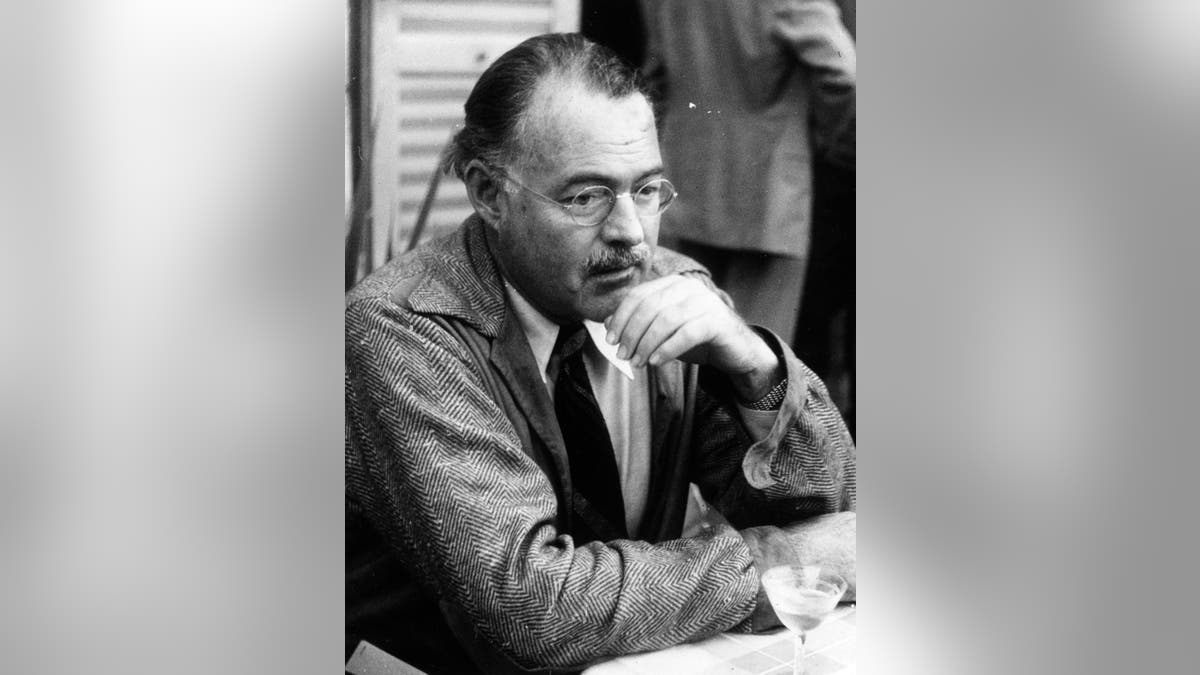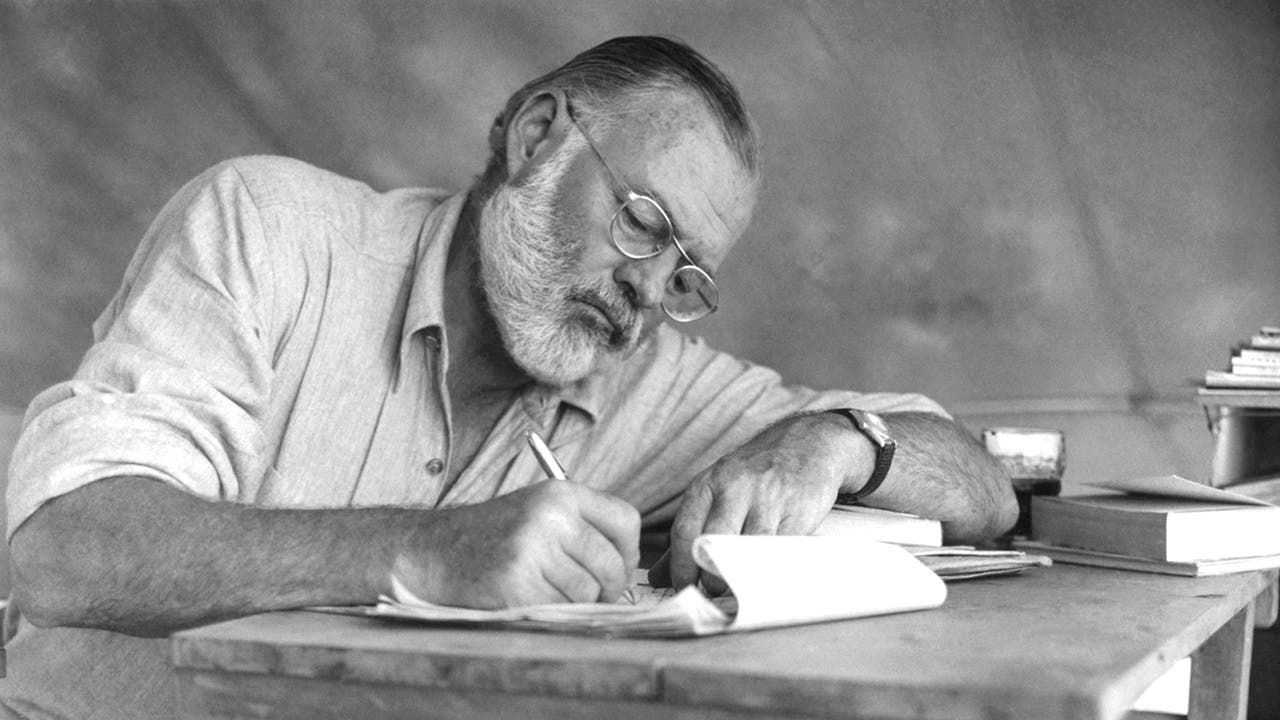On this historic date, July 8, 1918, iconic novelist Ernest Hemingway, then an 18-year-old ambulance driver for the American Red Cross, was hit by a mortar shell while serving on the Italian front along the Piave Delta in World War I, History.com noted.
Originally from Oak Park, Illinois, Hemingway was working as a reporter for The Kansas City Star when war broke out in Europe in 1914, the source said.
Hemingway volunteered for the Red Cross in France before the American entry into the war in April 1917; he was subsequently transferred to the Italian front.
ON THIS DAY IN HISTORY, JULY 7, 1930, CONSTRUCTION OF THE HOOVER DAM BEGINS
On the evening of July 8, 1918, Hemingway was hit by a mortar shell while handing out chocolate to Italian soldiers.
The incident left him unconscious; fragments of the projectile entered his right foot and knee and struck his thighs, scalp and hand, according to History.com.
American writer Ernest Hemingway (1899-1961) working at a portable table during a big game hunt in Kenya, September 1952. (Earl Theisen/Getty Images)
“However, two Italian soldiers who were between Hemingway and the point of impact of the shell were not so lucky. One was killed instantly and another lost both legs and died shortly afterwards,” the same source said.
Hemingway worked to ensure the safety of his fellow soldiers, getting them out of harm's way, according to The Ernest Hemingway Collection.
The Italian government awarded him the Silver Medal of Military Valor for his heroic actions, the source said.
“A Farewell to Arms” is set in the midst of World War I and weaves an enduring story of love and war.
Hemingway's experiences in Italy during World War I are said to have been integral to his larger-than-life personality, and provided the material for one of his best-loved novels, “A Farewell to Arms,” published in 1929.
ON THIS DAY IN HISTORY, NOVEMBER 29, 1832, 'LITTLE WOMEN' AUTHOR LOUISA MAY ALCOTT WAS BORN IN PHILADELPHIA
It tells of the love of a young American ambulance driver for a beautiful English nurse on the Italian front during the Great War, History.com said.
“A Farewell to Arms” weaves an enduring story of love and war while creating a historically accurate depiction of the Battle of Caporetto and the fight on the Italian front against German attacks, the National Veterans Memorial and Museum said.

In the midst of World War I, the interior of an American barracks in Lux (Côte-d'Or, France), in 1918. (adoc-photos/Getty Images)
“What makes this novel so interesting is that a significant part of 'A Farewell to Arms' was written autobiographically,” the same source said.
“Hemingway himself volunteered to be an ambulance driver on the Italian front during World War I and served for ten months in Europe. He experienced the harsh realities of war without serving as a soldier and even suffered injuries from a mortar bombardment on July 8, 1918.”
Hemingway was the first American to be awarded the Italian Silver Medal of Valor for carrying a wounded Italian soldier to safety, even though he himself was seriously wounded, according to the National Veterans Memorial and Museum.
“Due to his own injuries, Hemingway was taken to a hospital in Milan and was unable to continue his duties as an ambulance driver.”
“Due to his own injuries, Hemingway was taken to a Milan hospital and was left unable to continue his duties as an ambulance driver, which ultimately ended his tenure with the Red Cross,” the source said.
Florida attorney wins top prize in Ernest Hemingway impersonation contest
“A Farewell to Arms” tells how American lieutenant Frederic Henry, while working with the Italian ambulance service during World War I, meets English nurse Catherine Barkley, Britannica.com said.
“Although she still mourns the death of her fiancé, who died in the war, Catherine encourages Frederick's advances,” the same source said.
“After being seriously wounded by a trench mortar shell near the Isonzo River in Italy, he is taken to a hospital in Milan, where he is eventually joined by Catherine.”

The American novelist Ernest Hemingway (1899-1961) in Stresa, circa 1955. (Keystone/Getty Images)
While he recovers, Catherine cares for him, and during that time their relationship deepens.
Henry confesses that he is in love with her, and Catherine soon becomes pregnant with Frederic's child, Britannica.com reports.
The story continues when a hospital employee discovers that Frederic has hidden alcohol in his room and he is sent back to the front.
After the Battle of Caporetto (1917), he deserted from the army, escaping execution by the Italian military police.
She soon learns that she has been sent to Stresa, travels there by train and is reunited with Catherine.
Then, while in Milan, Federico looks for Catherine.
THE OLD MAN AND HIS SEA: HOW ERNEST HEMINGWAY'S KEY WEST HOUSE GENERATED SOME OF HIS BEST WORKS
He soon learns that she has been sent to Stresa, travels there by train, and reunites with Catherine. The couple flee Italy across the border into neutral Switzerland, Britannica.com noted.
He and Catherine are arrested by Swiss border authorities, but the couple is allowed to remain in Switzerland.
After living together for a while in Switzerland, Catherine goes into labor. Sadly, her child is stillborn and Catherine hemorrhages and dies.

This March 14, 1946 file photo shows author Ernest Hemingway with his new wife, Mary Welsh, after their wedding in Havana, Cuba. (The Associated Press/File)
The plot of the book is based in part on Hemingway's own experiences.
“Seriously wounded, he recovered in a Red Cross hospital in Milan, where he fell in love with one of the nurses,” the National Endowment for the Arts said.
For more lifestyle articles, visit www.foxnews.com/lifestyle
“This relationship turned out to be the model for the tragic romance between Frederick and Catherine in 'A Farewell to Arms.'”
And while the story's ending was different than Hemingway's life, both stories are tragic. “Both Hemingway and Frederic are left alone and wounded, without their love,” the University of Michigan said.
CLICK HERE TO GET THE FOX NEWS APP
In 1953, Hemingway received the Pulitzer Prize for fiction for “The Old Man and the Sea” (1952), a short heroic novel about an old Cuban fisherman who, after a long struggle, catches a giant marlin that is eaten by sharks during the long voyage home, according to Britannica.com.
In 1954, Hemingway received the Nobel Prize in Literature.
CLICK HERE TO SUBSCRIBE TO OUR LIFESTYLE NEWSLETTER
The Swedish Academy, which handed out the honor, said of the then-55-year-old American author in its citation: He was given the honor “for his powerful mastery of the style-setting art of modern storytelling, as evidenced most recently in 'The Old Man and the Sea,'” according to The New York Times.
Hemingway was 61 when he died by suicide on July 2, 1961.












